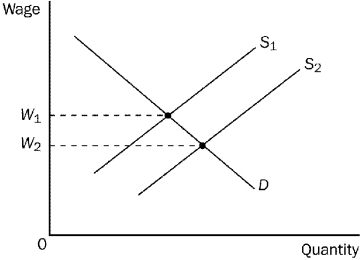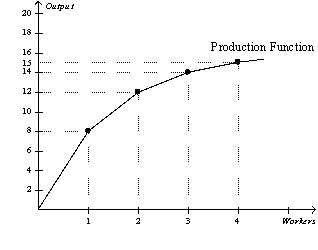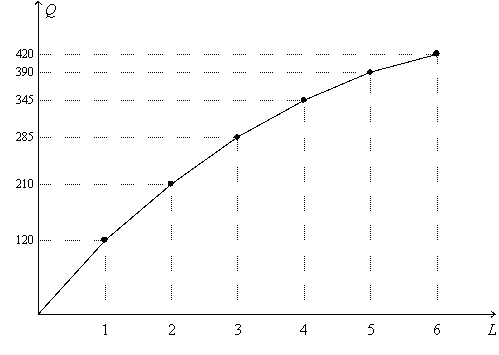A) (i) only
B) (ii) and (iii) only
C) (i) and (iv) only
D) (i) , (ii) , (iii) , and (iv)
F) B) and D)
Correct Answer

verified
Correct Answer
verified
True/False
Let L represent the quantity of labor,and let Q represent the quantity of output.Suppose a certain production function includes the points (L = 7,Q = 27),(L = 8,Q = 35),and (L = 9,Q = 45).Based on these three points,this production function exhibits diminishing marginal product.
B) False
Correct Answer

verified
Correct Answer
verified
Multiple Choice
Competitive firms that maximize profits will hire workers until the value of the marginal product of labor
A) equals the wage.
B) equals the price of the final good.
C) begins to fall.
D) begins to rise.
F) None of the above
Correct Answer

verified
Correct Answer
verified
Multiple Choice
Figure 18-7
 -Refer to Figure 18-7.When the relevant labor supply curve is S₁,and the labor market is in equilibrium,the
-Refer to Figure 18-7.When the relevant labor supply curve is S₁,and the labor market is in equilibrium,the
A) wage is W1.
B) opportunity cost of leisure to workers is W1.
C) value of the marginal product of labor to firms is W1.
D) All of the above are correct.
F) A) and B)
Correct Answer

verified
Correct Answer
verified
Multiple Choice
Suppose that a college physics experiment goes horribly wrong and releases an electronic pulse that renders all electronic equipment in the city of San Francisco,California permanently useless.No people are hurt,and no buildings are damaged.After the accident,the wages earned by California workers will
A) increase because the marginal productivities of workers will increase.
B) decrease because the marginal productivities of workers will decrease.
C) decrease because the marginal productivities of workers will increase.
D) increase because the marginal productivities of workers will decrease.
F) None of the above
Correct Answer

verified
Correct Answer
verified
Multiple Choice
The marginal product of labor is defined as the change in
A) output per additional unit of revenue.
B) output per additional unit of labor.
C) revenue per additional unit of labor.
D) revenue per additional unit of output.
F) C) and D)
Correct Answer

verified
Correct Answer
verified
Multiple Choice
Table 18-8
The following table shows the production function for a particular business. The numbers represent the various labor and output combinations the firm may choose for its output on a daily basis.
 -Refer to Table 18-8.What is the marginal product of the fifth unit of labor?
-Refer to Table 18-8.What is the marginal product of the fifth unit of labor?
A) 30 units
B) 40 units
C) 50 units
D) 250 units
F) B) and D)
Correct Answer

verified
Correct Answer
verified
Multiple Choice
Suppose that technological progress increases the productivity of teachers.Which of the following accurately describes the labor market for teachers after the technological change? Equilibrium wages will
A) rise, and the equilibrium quantity of teachers employed will fall.
B) rise, and the equilibrium quantity of teachers employed will rise.
C) fall, and the equilibrium quantity of teachers employed will fall.
D) fall, and the equilibrium quantity of teachers employed will rise.
F) B) and C)
Correct Answer

verified
Correct Answer
verified
True/False
Suppose the supply of capital decreases.As a result,the quantity of capital used in production and the rental price of capital will both fall.
B) False
Correct Answer

verified
Correct Answer
verified
Multiple Choice
For a competitive firm experiencing diminishing marginal productivity,the value of the marginal product (i) increases when the price of output decreases. (ii) changes when marginal product changes. (iii) diminishes as the number of workers rises.
A) (i) and (ii)
B) (i) and (iii)
C) (ii) and (iii)
D) All of the above are correct.
F) B) and D)
Correct Answer

verified
Correct Answer
verified
Multiple Choice
Figure 18-3
 -Refer to Figure 18-3.Suppose that the price of the output is $20.What is the value of the marginal product of the third worker?
-Refer to Figure 18-3.Suppose that the price of the output is $20.What is the value of the marginal product of the third worker?
A) $2
B) $10
C) $40
D) $280
F) C) and D)
Correct Answer

verified
Correct Answer
verified
Multiple Choice
If the value of the marginal product of labor is less than the wage,then the firm could
A) increase profit by hiring additional labor.
B) increase profit by reducing the amount of labor hired.
C) increase revenue by lowering output.
D) reduce total cost by hiring additional workers.
F) A) and D)
Correct Answer

verified
Correct Answer
verified
Multiple Choice
Table 18-7
Harold owns a cranberry bog in which he grows cranberries. Harold's farm is a competitive, profit-maximizing firm. Harold's production function is detailed in the table below.
 -Refer to Table 18-7.What is the marginal product of the fourth worker?
-Refer to Table 18-7.What is the marginal product of the fourth worker?
A) 250 bushels
B) 62.5 bushels
C) 50 bushels
D) 30 bushels
F) C) and D)
Correct Answer

verified
Correct Answer
verified
Multiple Choice
Table 18-10
Consider the following daily production data for Caroline's Cookies, Inc. Caroline's sells cookies for $2.50 each and pays the workers a wage of $325 per day.
 -Refer to Table 18-10.What is the value of the marginal product of the second worker?
-Refer to Table 18-10.What is the value of the marginal product of the second worker?
A) $180
B) $450
C) $950
D) $1,080
F) All of the above
Correct Answer

verified
Correct Answer
verified
Multiple Choice
Owners of land are compensated according to the
A) absolute level of production from the land.
B) number of laborers the land can support.
C) purchase price of the land stock.
D) value of the marginal product of land.
F) A) and C)
Correct Answer

verified
Correct Answer
verified
Multiple Choice
Table 18-8
The following table shows the production function for a particular business. The numbers represent the various labor and output combinations the firm may choose for its output on a daily basis.
 -Refer to Table 18-8.Suppose this firm charges a price of $5 per unit of output and pays workers a wage equal to $160 per day.What is the value of the marginal product of labor for the fourth worker?
-Refer to Table 18-8.Suppose this firm charges a price of $5 per unit of output and pays workers a wage equal to $160 per day.What is the value of the marginal product of labor for the fourth worker?
A) $200
B) $1,000
C) $6,400
D) $32,000
F) A) and D)
Correct Answer

verified
Correct Answer
verified
Multiple Choice
For a competitive,profit-maximizing firm,the demand curve for labor will shift in response to a change in the
A) wage rate.
B) quantity of labor demanded.
C) price of the product that the firm sells.
D) an increase in the supply of labor.
F) None of the above
Correct Answer

verified
Correct Answer
verified
Multiple Choice
Figure 18-1. On the graph, L represents the quantity of labor and Q represents the quantity of output per week.
 -Refer to Figure 18-1.The figure illustrates the
-Refer to Figure 18-1.The figure illustrates the
A) demand for labor.
B) supply of labor.
C) production function.
D) wage function.
F) All of the above
Correct Answer

verified
Correct Answer
verified
True/False
If a firm is able to charge a higher price for its output,all else equal,the value of the marginal product of labor will decrease to offset the higher price.
B) False
Correct Answer

verified
Correct Answer
verified
Multiple Choice
Figure 18-1. On the graph, L represents the quantity of labor and Q represents the quantity of output per week.
 -Refer to Figure 18-1.Suppose the firm sells its output for $12 per unit,and it pays each of its workers $700 per week.How many workers will the firm hire to maximize its profit?
-Refer to Figure 18-1.Suppose the firm sells its output for $12 per unit,and it pays each of its workers $700 per week.How many workers will the firm hire to maximize its profit?
A) 2
B) 3
C) 4
D) 5
F) B) and C)
Correct Answer

verified
Correct Answer
verified
Showing 41 - 60 of 463
Related Exams